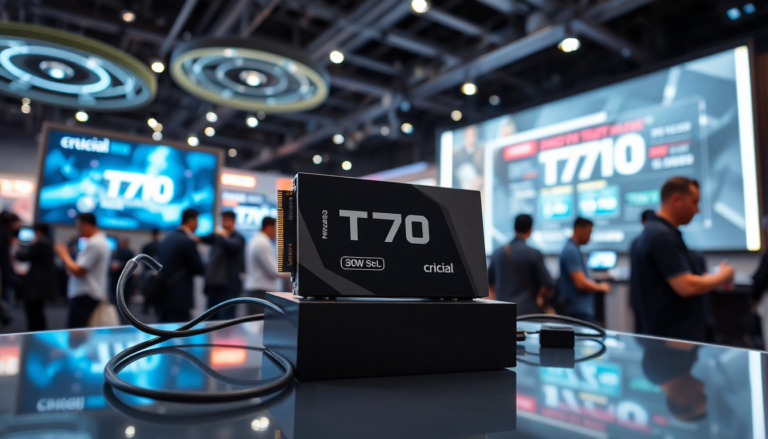Argomenti trattati
In the fast-paced world of technology, the continuous push for faster, slimmer, and more efficient devices is relentless. At Computex 2025 in Taipei, Crucial showcased its groundbreaking T710 SSD, setting new standards in storage technology. With speeds reaching an astonishing 14.9 GB/s and 2.2 million IOPS via the PCIe 5.0 interface, this SSD promises to leave its predecessor, the T705, in the dust. What makes this launch so exciting? Let’s dive into the features that set the T710 apart and how it could transform your computing experience.
What’s new in the Crucial T710 SSD?
The T710 SSD isn’t just faster; it’s also designed with a sleeker profile that caters to modern laptops. This new model manages to pack impressive performance into a single-sided form factor, a crucial upgrade from the T705 that allows for broader compatibility with various OEM devices. But what really caught my attention was the reduction in thickness of the heatsink-equipped model, which has been slimmed down from 21mm to just 11mm. I remember when bulky SSDs were the norm, and now here we are—witnessing a revolution in compact design. The new circular air channels not only enhance cooling but also contribute to the overall aesthetic appeal of the drive.
Performance metrics that impress
Speed is the star of the show for the Crucial T710. With random read performance reaching up to 2.2 million IOPS—a staggering 28% improvement over its predecessor—and random write performance of 1.8 million IOPS, there’s no denying that this SSD is built for serious tasks. I can almost feel the adrenaline rush when I think about the potential for gamers and content creators who demand top-tier performance. And let’s not overlook the power efficiency; the T710 reduces power consumption by 67% during read operations and an astonishing 80% during write tasks. This means less heat and longer battery life—what’s not to love?
Storage capacities and endurance
Crucial offers the T710 SSD in various storage capacities: 1TB, 2TB, and 4TB. The peak sequential read/write speeds of 14.9 GB/s and 13.8 GB/s, respectively, are impressive, but what truly matters is how this translates into day-to-day performance. Depending on the storage capacity, the write endurance varies between 600 and 2,400 TBW (terabytes written). This flexibility ensures that users can choose the right model according to their needs, whether they’re casual users or heavy-duty professionals.
X10 series portable SSDs: A new contender
Alongside the T710, Crucial also unveiled its X10 series of portable SSDs, which are designed to impress with speeds up to 2,100 MB/s—double that of the previous generation. I’ve always been a fan of portable storage solutions, and the X10 series presents a perfect blend of portability and speed. It’s available in a wide range of capacities, including an unusual 6TB option, which fills a gap I never knew existed. The drive’s IP65 rating for dust and water resistance makes it a robust choice for those on the go, and its drop resistance of up to 9.8 feet is quite a game-changer for clumsy tech enthusiasts like myself.
The future of USB4 technology
Crucial’s foray into the USB4 technology realm is also noteworthy. They showcased a prototype portable SSD capable of delivering up to 4,000 MB/s read speeds. However, the company remains cautious about committing to a market release—after all, who wants to deal with compatibility issues? I can relate to the frustration many users feel regarding inconsistent support from motherboard manufacturers. It’s about time we had a seamless solution that truly harnesses the potential of external SSD speeds.
What’s next for Crucial?
The T710 without a heatsink is set to launch on July 1, and I can’t wait to get my hands on one for a full review. For enthusiasts eagerly awaiting the heatsink-equipped version, it’s expected to arrive later this summer. With these innovations, Crucial is not just keeping pace with the industry; they’re setting the benchmark for what SSDs can achieve. As technology continues to evolve, I’m excited to see how these advancements shape our digital experiences and what Crucial has up its sleeve next.

